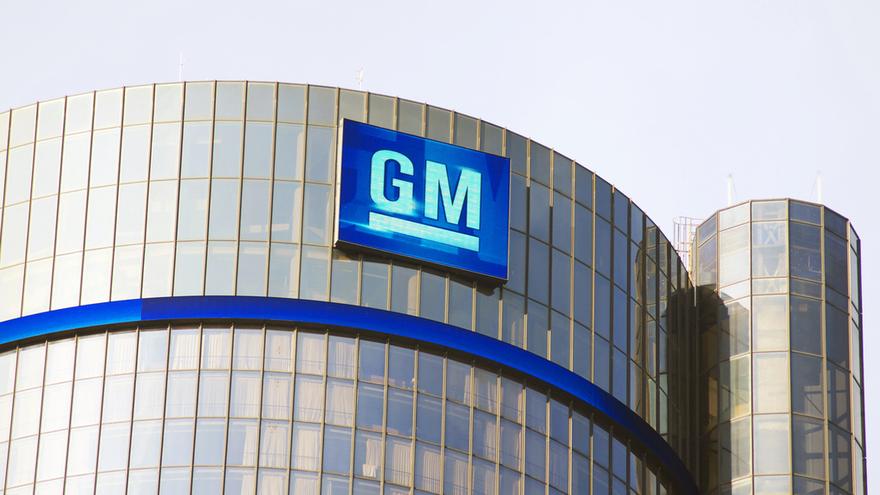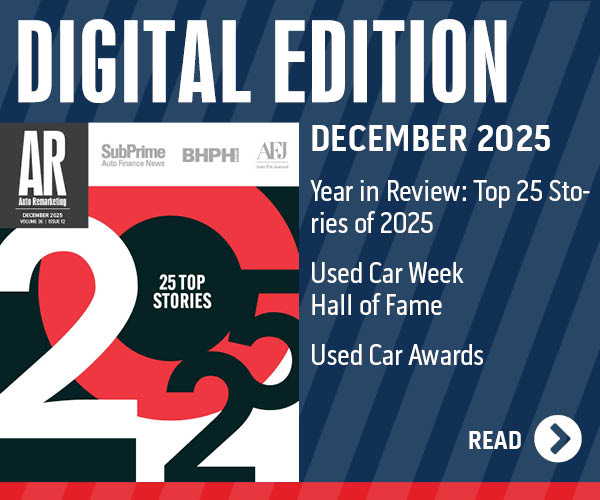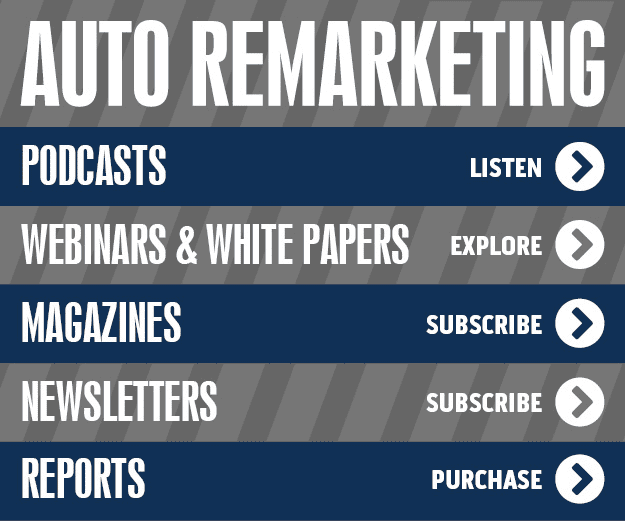Based on how the flow of tax refunds impact the used-vehicle market, Cox Automotive wasn’t surprised by the movement of wholesale prices in March.
According to Manheim Used Vehicle Value Index — a measure of wholesale prices adjusted for mix, mileage and season — wholesale used-vehicle prices decreased slightly in March compared to February. But March prices climbed 5.4 percent from year-ago levels.
At 130.8, the index is at its lowest level since July 2017, a point just prior to when Hurricanes Harvey and Irma began to impact the market.
“The marginal price decline in March was not significant,” said Jonathan Smoke, chief economist for Cox Automotive. “The slight decline in the seasonally-adjusted index value was the result of the adjustment process expecting more of an increase in March, but delays in tax refunds have shifted the peak of used-car demand by several weeks.
“Looking ahead, we are expecting strong pricing in April and May, as tax refunds more fully impact the used-car market,” Smoke continued.
Delving deeper into the March wholesale data, analysts found several segments with prices moving higher.
In fact, Manheim noticed every vehicle segment posted wholesale price increases compared to last year, with an especially strong gain once again in vans. First quarter wholesale price trends for all segments included:
— Compact car prices represent significant strength, with a 5.4 percent increase over 2017. That’s even more than the typically strong SUV/crossover segment.
— The midsize car segment was the weakest performer, but unlike previous quarters, the segment did not experience a decline, posting instead an increase of 0.9 percent over 2017.
— Pick-ups and vans both showed strength, with vans increasing significantly thanks to a 13.4-percent gain compared with March of last year. Manheim added that pick-ups had a comparatively modest increase of 5.5 percent.
—Wholesale pricing for SUVs and crossovers underperformed the overall market, increasing 5.1 percent from last year. Analysts explained the underperformance is likely due to an increasing supply of used SUVs and more aggressive pricing and incentive spending on new inventory.
— Luxury car values once again underperformed the overall market, increasing 4.1 percent over the same period last year.
Also of note, Manheim determined rental-risk pricing strengthened in March, with the average price for rental-risk units sold at auction up 7 percent over last year and 4 percent compared to February.
Analysts added the average mileage of 45,000 for rental-risk units in March was 13 percent higher than last year.
Correlating the used-vehicle market with the tax calendar
After plowing through the March wholesale pricing data, Cox Automotive returned back to a discussion about IRS activities and a recap of how retail sales landed in March.
Historically, Cox Automotive acknowledged used-vehicle sales in the U.S. have peaked in the weeks following the peak in tax refunds. Starting in 2017, however, the IRS delayed the point when households with eligible tax credits could file tax returns. This resulted in refunds being delayed by approximately four weeks, impacting used-vehicle sales and pricing.
“This same situation is impacting 2018, as well,” analysts said.
Used-vehicle sales in March increased 1 percent over year-ago levels, according to Cox Automotive estimates, with the month’s seasonally adjusted annual rate (SAAR) for used vehicles rounding out at 39.5 million units.
Since 2009, the average March increase relative to February in the Manheim Used Vehicle Value Index has been 3.5 percent, just slightly higher than the March 2018 unadjusted increase of 3.4 percent.
Analysts explained the historical bump in March pricing has been driven by an increase in used-vehicle demand driven by earlier tax refunds.
“The seasonal-adjustment process still expects to see this historical pattern in used-vehicle values,” Cox Automotive said. “As a result, the seasonally adjusted value for March registered the slight 0.15 percent decline.”
Through the week of March 23, Cox Automotive mentioned the cumulative number of refunds in 2018 is down 1 percent compared to 2017.
“The weekly trend in refunds, however, relative to last year, is now trending up, with experts predicting a stronger price trend in April as retail used-car demand will likely peak for the year,” analysts added.
Meanwhile, on the new-car side, Cox Automotive recapped that new-vehicle sales increased 6 percent year-over-year in March, coming in far stronger than forecast and surprising most analysts and experts.
The March 2018 new-vehicle SAAR of 17.4 million, up from 16.7 million in 2017, marked the seventh straight month of more than 17 million SAAR and the third best March on record.
“Cars continue to experience sharp declines in the market, with sales last month falling 9 percent compared to year-earlier levels. Trucks and SUVs continued to gain share,” analysts said.
The latest commentary from Comerica Bank also touched on new-vehicle sales, noting how challenging it is to project future figures.
“Forecasting auto sales is now a two-handed argument,” Comerica Bank chief economist Robert Dye said.
“On the one hand, strong economic conditions are supportive of ongoing auto sales,” Dye continued. “On the other hand, sales were declining through the first eight months of 2017, then came the surge in sales in September as a result of hurricane damage along Gulf Coast.
“We expect to see gradually easing auto sales this year,” he added.
Trends and economic momentum
Cox Automotive closed its latest index update by noting some general economic news.
Analysts mentioned the fourth quarter's real GDP growth rate was revised upward to 2.9 percent from its previous 2.5 percent.
“Expectations remain for a continuation of accelerated growth this year due in part to increased consumer spending and business investment resulting from recent tax reform,” Cox Automotive said.
“Despite consumer confidence last month experiencing a moderate decline from a 17-year high in February, largely due to stock market volatility, consumer spending expectations remain high due to tax cuts, strong wage growth and the robust labor market,” the company went on to say.
Dye also discussed an important component in dealerships turning vehicles — their customers having a job to generate income and pay their installment contract.
Dye explained the official federal employment data for March was “eye-catching” as firms increased employment by just 103,000 jobs on net, “well below consensus expectations” of about 185,000 for the month. He pointed out the miss in March payrolls comes on the heels of a robust 326,000 job gain in February.
“The March slump looks like mean reversion right now,” Dye said. “If it is followed by a weak April, that is another story, but other indicators point to ongoing moderate job growth this spring.
“The unemployment rate stayed at 4.1 percent for the sixth consecutive month,” he continued. “We still expect it to edge lower, but the rate of decline has clearly eased.
“Average hourly earnings increased by 0.3 percent for the month and are up 2.7 percent over the previous year,” Dye went on to say.
Along with recapping some of the full-year used-vehicle metrics he discussed during NADA Show 2018, KAR Auction Services chief economist Tom Kontos also pinpointed wholesale price movements for February.
According to ADESA Analytical Services’ monthly analysis of wholesale used-vehicle prices by vehicle model class, wholesale used-vehicle prices in February averaged $10,707, which was 2.5 percent lower compared to January and 0.2 percent higher relative to February 2017.
Kontos noted that sporty cars made the highest price jump in February, climbing by 4.5 percent.
He added that decliners were paced by full-size cars, which softened by 6.6 percent.
According to his presentation shared during the annual event hosted by the National Automobile Dealers Association, there was a 2.0-percent lift in used-vehicle transactions in 2017. The combination of turns at franchised and independent stores as well as deals made by private parties resulted in 41.38 million used-vehicle sales last year, according to Kontos.
The 2017 figure represented a jump of 827,000 units, with private sales constituting more than half of that amount. Here is a breakdown of the full-year figure:
— Sales at franchised dealerships: 15.1 million
— Sales at independent dealerships: 14.1 million
— Private party transactions: 12.1 million
Also of note within Kontos’ NADA material, the KAR expert mentioned how 2017 also marked a significant drop if sales into rental fleets. Last year, the industry saw a drop-off of 12.3 percent or 222,544 units go into the rental market.
Still, Kontos indicated automakers still sent 1,592,380 new vehicles into rental fleets in 2017.
And one other full-year metric Kontos shared focused on sales volume by seller type. Fleet/lease consignors posted a 10.3 percent year-over-year volume lift in 2017 while manufacturers sustained a softening of 14.7 percent. Kontos also pegged dealer consignment volume as being down by 4.0 percent year-over year.
“Dealer consignment volumes are down as dealers take fewer new-car trades,” Kontos said in his presentation. “Declining manufacturer volumes reflect lower rental sales and recall delays. Off-lease and repo volumes are reflected in growing fleet/lease sales.”
ADESA Wholesale Used-Vehicle Price Trends
| |
Average |
Price |
($/Unit) |
Latest |
Month Versus |
| |
February 2018 |
January 2018 |
February 2017 |
Prior Month |
Prior Year |
| |
|
|
|
|
|
| Total All Vehicles |
$10,707 |
$10,980 |
$10,688 |
-2.5% |
0.2% |
| |
|
|
|
|
|
| Total Cars |
$8,609 |
$8,751 |
$8,732 |
-1.6% |
-1.4% |
| Compact Car |
$6,563 |
$6,698 |
$6,658 |
-2.0% |
-1.4% |
| Midsize Car |
$7,702 |
$7,880 |
$7,942 |
-2.3% |
-3.0% |
| Full-size Car |
$7,554 |
$7,853 |
$8,092 |
-3.8% |
-6.6% |
| Luxury Car |
$13,132 |
$13,170 |
$13,015 |
-0.3% |
0.9% |
| Sporty Car |
$14,079 |
$13,987 |
$13,478 |
0.7% |
4.5% |
| |
|
|
|
|
|
| Total Trucks |
$12,647 |
$13,074 |
$12,650 |
-3.3% |
0.0% |
| Minivan |
$8,714 |
$9,048 |
$9,004 |
-3.7% |
-3.2% |
| Full-size Van |
$13,032 |
$12,980 |
$12,838 |
0.4% |
1.5% |
| Compact SUV/CUV |
$10,638 |
$10,680 |
$10,733 |
-0.4% |
-0.9% |
| Midsize SUV/CUV |
$11,083 |
$11,578 |
$11,319 |
-4.3% |
-2.1% |
| Full-size SUV/CUV |
$13,411 |
$14,648 |
$13,140 |
-8.4% |
2.1% |
| Luxury SUV/CUV |
$18,101 |
$18,466 |
$18,258 |
-1.9% |
-0.9% |
| Compact Pickup |
$8,977 |
$9,306 |
$8,818 |
-3.5% |
1.8% |
| Full-size Pickup |
$16,635 |
$16,190 |
$15,796 |
-3.4% |
-1.0% |
Source: ADESA Analytical Services.
Both Cox Automotive senior economist Charlie Chesbrough and Autotrader executive analyst Michelle Krebs each shared a cautionary reaction on Tuesday morning just hours after General Motors announced that the automaker will begin reporting its U.S. vehicle sales on a quarterly basis, effective immediately.
Contained in the closing segment of what evidently is its last monthly sales announcement, GM explained that now second quarter sales will be released on July 3, third quarter sales on Oct. 2 and fourth quarter sales on Jan. 3 of next year.
“Thirty days is not enough time to separate real sales trends from short-term fluctuations in a very dynamic, highly competitive market,” said Kurt McNeil, U.S. vice president of sales operations at GM. “Reporting sales quarterly better aligns with our business, and the quality of information will make it easier to see how the business is performing.”
In the auto industry, GM emphasized monthly sales are subject to many issues that make them more volatile than quarterly sales, including product launch activity, weather, other seasonal factors, the number of selling days and incentive activity.
GM also added that its “high level of transparency” on total, brand and nameplate sales, fleet mix and inventory will not change. The company will also continue sharing J.D. Power PIN estimates for incentive spending and average transaction prices.
Chesbrough replied first when Auto Remarketing asked for a reaction to GM’s decision during a conference call Cox Automotive hosts on a monthly basis.
“I think for GM, they feel like this is going to be a time saver,” Chesbrough said. “They won’t be scrambling so much to get the news out at the start of each month. They feel maybe they’re chasing a little too much monthly volatility, which might be out of their control. And they haven’t been able to focus enough on bigger picture stories they could focus on a quarterly basis. I think that’s the general idea.”
If a company as large as GM makes this decision, what about other members of the Big 3 or leading foreign automakers?
“Our expectation is that other companies are going to likely follow,” Chesbrough said. “We don’t know how many, but I wouldn’t be surprised to see a couple of other big OEMs also decide to move to quarterly reporting basis.”
If that does in fact happen, Chesbrough touched on what the implications could be.
“I think the danger for the industry and where there are risks are for the companies themselves,” he said. “They probably will have less control over the narrative of what’s going on each month, if their sales are up or down, it’s going to be up to whatever analyst says they are or what reporters decide they’re going to be since we won’t know the facts themselves. I think there is some risk to that.
“Also, what replaces that information source? Is the industry able to find a viable replacement other than GM reporting those numbers themselves? Certainly, we all want to know what’s happening in the industry on a real-time basis because we know the auto industry is an important component for Wall Street in terms of monitoring the overall health of the economy,” Chesbrough went on to say. “I think people are going to want to know and have some kind of a measurement as to how sales are progressing.”
For Krebs, she approached from the perspective on how the GM decision could be create a much greater impact than knowing how many new trucks or sedans franchised dealerships turned in a given month.
“I was around in the lead up to the recession, and auto sales were a bellwether of the economy,” Krebs said. “We might not get at least a public lead on that without seeing monthly sales. But I understand why GM is doing it. Other industries do it. In the real estate industry, they switched over. Other retailers like Wal-Mart and Target, they don’t do monthly sales. I get it on that respect.
“And if you look at the first quarter as an example, January and February are really low months and March is a very high month so looking quarterly does even things out,” she continued.
There is a lot of nuance that I think is often lost, things that we try to provide here,” Krebs went on to say. “What are inventories levels? Are they low or high? How does that effect sales? Things like incentives. There are a lot of nuances that don’t always get reported.”
While Chesbrough, Krebs and their colleagues won’t have GM data to review at the top of each month, they’re still primed to watch other metrics and assess accordingly.
“At this point, we’re still reacting ourselves as to what Cox Automotive is going to do, but we plan to continue to provide information on a monthly basis,” Chesbrough said.
As the industry counts how many used vehicles were retailed during March, the dealer survey orchestrated by KeyBanc Capital Markets in February gauged how stores continue to have some struggles despite rising turns in their used departments.
Survey orchestrators reported that gross-profit trends continued to reflect competitive pressure in new and used segments, which should continue to be offset by strength in F&I gross profit per unit, while parts and service gross margins remained intact at near-record highs.
Within new vehicles, KeyBanc found that a slight majority of dealer respondents — 55 percent to be exact — reported a pullback in gross profit per unit, a worsening versus the rolling three-month average of 43 percent.
On the used-vehicle side, the survey showed that 45 percent of participating dealer reported a pullback in gross profit per unit, in line with the rolling three-month average of 43 percent.
KeyBanc added that F&I gross profit per unit remained strong with 91 percent reporting intact or increasing results year-over-year.
Furthermore, KeyBanc mentioned that 64 percent of respondents reported intact P&S gross margin, in line with the rolling three-month average of 63 percent.
Also of note, dealers told KeyBanc that financing remains attractive to keep metal moving.
“Overall automotive financing and subprime financing availability continued to contract, not unusual at the peak of the cycle, but credit available remains well aligned with demand,” KeyBanc said.
General Motors president Dan Ammann acknowledged the situation involving overall off-lease volume in the wholesale market and how the automaker and its captive — General Motors Financial — set residual values created some notable stress.
“We were just saying last night that when we were together a year ago, we were quite concerned, but we feel a lot better about it now,” Ammann said during a conversation with industry media after his opening keynote presentation during last week’s Vehicle Finance Conference hosted by the American Financial Services Association.
Ammann then differed to the executive seated next to him inside a marble-clad boardroom at the Bellagio in Las Vegas to elaborate on why GM’s assessment of the used-car market is less concerning now. That colleague was GM Financial president and chief executive officer Dan Berce, who took his turn on stage during a panel discussion later at AFSA’s event.
“Obviously at this time last year, used-car prices were down in the neighborhood of 7 percent year-over-year,” Berce began. “Now more recently, year-over-year stats have been flat. That certainly doesn’t mean that the residual-value matter is behind us because there are still going to be a lot of off-lease vehicles this year and through 2019 before supply starts to flatten out.
“Residual value management is really a joint effort between GM and GMF,” Berce continued. “GM has taken some steps to strengthen residual values with their management of inventory and management of their fleet sales versus retail. Their incentive spend has been favorable to residual values.
“It really starts from the OEM, but from a finance company standpoint, we do all of the remarketing, whether it’s off-lease, company cars, fleet,” Berce went on to say. “We’ve got good technology with the combination of online sales and physical auctions. We have a pretty good optimization model where we can figure out what markets the cars should go to, what the best price point is.”
Of course, after many of those vehicles navigate their way through the remarketing channels, they end up at GM franchised dealerships as certified pre-owned models. And GM has had a robust start to 2018 with its CPO sales.
In January, Chevrolet, Buick and GMC stores turned a total of 27,635 CPO units, according to information compiled and shared by Autodata Corp. That January figure represented an 8.2-percent lift year-over-year.
Then in February, Autodata indicated GM’s certified program registered 29,229 retail sales, marking a 4.5-percent improvement year-over-year.
And also of note, Cadillac CPO sales — which are associated with a separate program — is building off a record year in 2017 when the brand turned 48,245 units. After compiling a 37.9-percent sale jump for all of 2017, the luxury badge has started each of the first two months of 2018 with double-digits gains, according to Autodata.
Likely all of those encouraging trends are why Ammann, Berce and the GM and GM Financial teams are upbeat about the used slice of its broad operations.
“CPO is an important part of the residual value strategy. It’s a vehicle that the consumer prefers in most cases because of reliability and the OEM standing behind it. That’s certainly good from a residual value perspective to have a good CPO program,” Berce said.
As mentioned, Ammann delivered the opening presentation of AFSA’s annual gathering of auto finance leaders. He discussed not only GM’s current state of affairs but also how the automaker is part of the industry-wide advancement in technology with the end goal being autonomous vehicles. For example, in just a few months, GM plans to release a vehicle designed without a steering wheel.
James Treece of Automotive News asked Ammann about how GM is handling the conundrum of consumers often waiting for at least the second generation of a technologically advanced vehicle before taking delivery and how that condition might impact leasing and eventually the certified prospects for the first iteration of a model.
“That’s a very good question,” Ammann began. “One of the big changes that’s happening right now is how cars are upgradable and technology is upgradable. We will be adding features over time.
“We’ve gone from this historical mindset that’s perfectly logical that you buy a car and it depreciates, to now you buy a car and it can get better over time, more features, more capability with updates,” he continued. “That’s a very significant change and arguably could have a very positive effect on residuals and CPO.”
Pre-owned vehicles sales reached a record high last year of 39.2 million, according to the 2017 Edmunds Used Car Report.
This was up 1.6 percent from 2016. And for perspective on how much used sales growth the industry has experienced in the past five years, that number represents a 4.3-percent increase from 2012.
So, why the record highs last year? Most of the spike can be attributed to an increase in used inventory stemming from off-lease vehicles hitting the market — as well as heightened demand for replacement vehicles due to Hurricanes Harvey and Irma.
Edmunds analysts also pointed out that this very same increase in off-lease models has also served to slow used-vehicle price growth. Prices rose by just 1.4 percent last year, according to the report. That’s after spiking by an average of 3.6 percent every year from 2012-2016.
“Consumer demand for SUVs — which were limited in supply — is really what helped fuel the modest price growth that the used market eked out in 2017,” said Ivan Drury, senior manager of industry analysis at Edmunds.
Consequently, shoppers in the market for passenger cars might be in luck. Drury expects these shoppers to find deals on 2- to 3-year-old passenger cars, “since their residual values were hit so hard” by the aforementioned trend in SUV shopping.
In fact, a recurring theme throughout the report: The increase in near-new off-lease vehicles is putting pressure on residual values.
As such, Edmunds took a look at trends in the rental fleet market to get a handle on the trends. Edmunds analysts found the number of new vehicles sold to rental agencies and the number of vehicles leased by consumers dropped to 5.9 million vehicles last year, compared to 6.2 million in 2016.
“Looking forward, we expect to see leasing become more expensive as interest rates climb and residuals continue to fall,” Drury said. “However, rental sales are at risk of slowing as more consumers gravitate toward ride-hailing services and peer-to-peer car sharing.”
That could lessen supply in the future – making way for stronger residual values — but automakers are fully aware of the softening numbers in today’s market. And they are taking action in an effort to keep sales volumes high, while also protecting fragile residual values.
For example, since trucks and SUVs tend to hold their value better, rental car customers are going to be finding more larger vehicles “equipped with unexpected creature comforts,” Edmunds.com pointed out. And then, of course, that means more of these very same expensive models on dealer's used lots in the next two to three years.
“Years ago, strong residuals allowed automakers the ability to be more liberal in their short-term sales strategies, but as residuals begin to fall in more vehicle categories, sales driven by retail leasing and daily rentals will become increasingly scrutinized,” said Drury. “Companies will need to balance their portfolios going forward in order to minimize residual losses.”
For more insight from the latest Edmunds Used Car Report, stay tuned to Auto Remarketing Today, where we will be covering different aspects and analysis of the annual offering.
The newest dealer survey from KeyBanc Capital Market showed the opening month of 2018 was a fruitful one for dealerships’ used-vehicle departments.
According to the results shared Friday, the majority of respondents — 75 percent to be exact — continued to report increasing used-vehicle sales in January.
“We are anticipating a low single-digit used-car volume increase in 2018, driven by positive unemployment trends and continued improvement in off-lease supply,” KeyBanc analysts said.
And closely tied to used vehicles, the survey highlighted that dealerships are enjoying a robust start within their service drives, too.
The survey again showed the majority of respondents — this time 69 percent — continued to report increasing parts and service revenue, maintaining a positive trend in this segment.
“We maintained our low to mid-single-digit P&S revenue growth outlook into 2018, in line with the 2017 trend driven by increasing zero to 7-year-old vehicles, increasing used-vehicle sales that drives reconditioning work into bays and favorable warranty trends,” analysts said.
KeyBanc noted that positive used vehicle and P&S revenue trends should offset a “modest” 0.8 percent year-over-year pullback in new-vehicle sales volume.
“We are maintaining our full-year 2018 outlook of a 2 percent, or 16.8 million vehicles, in line with the midpoint of consensus SAAR range of 16.5 million to 17.0 million units,” analysts said.
No matter whether the stores are turning used vehicles or new models, the KeyBanc report pointed out that overall auto financing and subprime financing availability continued to contract slightly. Analysts added the trend “is not unusual at peak of the cycle, but credit availability remains well aligned with demand.”
And when it comes to gross profit, the KeyBanc survey showed a mix bag of trends.
When it comes to F&I gross profit, 46 percent of survey respondents reported intact gross per unit while another 38 percent reported an increase of about $50 year-over-year.
For gross on used vehicles, about the same number of responding dealers posted a rise of least $50 per unit in January as the ones that sustained a drop of about $50 per unit to open 2018.
Just like that four-cylinder engine in a 2017 model is probably much more efficient and robust than the same level power plant in a vehicle 10 years older, Asbury Automotive Group is anticipating an ongoing software upgrade will rev up its used-vehicle department to a much higher performance than what the dealer group experienced to close the fourth quarter.
Acknowledging the software changeover had an noticeable impact, Asbury reported that its Q4 same-store used-vehicle retail revenue decreased 6 percent year-over-year while gross margin dropped by 10 percent on the same time comparison.
In terms of units, Asbury retailed 17,822 used vehicles during the fourth quarter, a drop-off of 2,059 vehicles or 10 percent year-over-year.
For the year, Asbury retailed 76,929 used vehicles, down 3 percent or 2,330 units compared to the 2016 total. The dealer group’s average gross profit per used unit retailed dipped 5 percent or $79 in 2017 to $1,574.
While those might be some negative figures, Asbury leadership is hopeful a dramatic software upgrade — expected to be completed by the close of the second quarter of this year — will provide the lift the company needs to enjoy record used-vehicle performance.
Asbury senior vice president of operations John Hartman told investment analysts during a February conference call, “While the new software will benefit us in the long-term, the implementation led to business disruption, putting pressure on our used sales.”
Later in the call, Hartman elaborated about some of the software’s capabilities.
“The biggest difference is we track market-day supply on used,” Hartman said. “Now if we look at a vehicle, if it has a low market-day supply, we know that vehicle will turn quicker and we can price it appropriately versus a vehicle that has a high market day supply and there's abundance of them in the market. We need to price that more aggressively to move it quicker. So the data is much more fine-tuned.”
Asbury president and chief executive officer David Hult immediately chimed in saying, “The other significant increase I’ll add to that, from appraising the vehicle, it’s more real time data, meaning today and this week what’s happening and the old software was really a 90-day look back.”
While Hult didn’t specify exactly how old Asbury’s software, it might be fair to assess that the platform might have been limited like that four-cylinder engine only pushing out a little more than 100 horsepower.
“We’re not a huge a company, but anytime you change something across the enterprise, it’s painful, so you put it off for long periods of time,” Hult said.
“The software we had was serviceable, but the data that it gave us wasn’t as timely as what the new software gives us,” he continued. “The new software is far more complex and more data-driven than the old, so we’re confident once we get comfortable with it, we’ll really be able to increase our turn, which is what we’re focused on. We want to turn the inventory faster and naturally grow our volume through trades.”
Top-line measurements
In other parts of its financial statement, Asbury reported its Q4 net income came in at $42.5 million or $2.03 per diluted share, down compared to $67.1 million or $3.08 per diluted share in the prior-year quarter.
The company explained its net income for the fourth quarter was adjusted for a $5.1 million pre-tax loss for franchise rights impairments ($0.15 per diluted share) and a $7.9 million benefit ($0.37 per diluted share) related to adjustments to deferred tax balances as a result of recent changes to the tax law.
As a result of recent changes to the tax law, Asbury is expecting its effective tax rate to be between 25 percent and 26 percent in 2018, which is down from its prior guidance of approximately 38 percent.
Finance office update
Asbury’s F&I performance was a bright spot during the fourth quarter. The dealer group posted a year-over-year lift of 10 percent or $153 in F&I gross profit per unit, landing at $1,652.
And by and large, Hult indicated that Asbury has the access to get its customers financed.
“I haven’t seen a big shift in the credit at all, as far as in the subprime market, which is a small percent of our business. The stipulations are getting a little bit tighter, but credit availability hasn’t been an issue in all the tranches,” he said.
Dumping sedans into fleet sales is certainly a path-of-least-resistance option leveraged by automakers in the past, but experienced used-car market observers understand the severe damage that strategy can do.
However, in light of technology advances and consumer preferences — not only in the United States but also globally — pulling the fleet lever doesn’t quite have the keep-the-metal moving impact that automakers experienced, especially when it comes to those sedans.
Cox Automotive senior economist Charlie Chesbrough and Autotrader executive analyst Michelle Krebs explained why during a conference call earlier this month.
“Consumers are clearly indicating that they love crossovers, and they can’t get enough of them,” Chesbrough said.
“We don’t see an end to this shift,” said Krebs, who later added, “There has to be a lot of contemplation going on in product planning meetings about how many car models and how much car production capacity each automaker has versus their utility lines and those capacities. I’m sure those discussions are going on.”
Perhaps those discussions are happening particularly within the meeting spaces in Michigan where domestic automakers have a noticeable presence in fleet sales. Here’s a quick rundown of what the Big 3 reported in the fleet department for January:
— Ford: Fleet sales of 45,956 vehicles were down 12.0 percent due primarily to a planned change in delivery timing of daily rental sales.
— General Motors: The automaker indicated 23.8 percent of January sales went into the fleet segment, representing a 2.9-percent lift year-over-year.
— Fiat-Chrysler: The OEM reported fleet activity accounted for 16 percent of total January sales.
The reported metric from Chrysler struck Chesbrough, who said, “That’s a fairly healthy range to be in, if you had to pick a number for fleet.
“Early indications are that there may be some agreements between the OEMs on who they’re supplying. Whether this trend carries through the rest of the year, we don’t know. Fleet was a big story last year. Cutting back in fleet by a couple hundred thousand units basically took us back from being close to another record sales level to seeing sales come in a little bit below,” he continued.
“So if fleet is weak again, it does suggest the market is going to have a hard time hitting even the high 16 million that most forecasters have right now,” Chesbrough went on to say.
And when even fleet sales are soft for a particular new model, Chesbrough explained that automakers now have limited options to retail those units beyond the United States, previously a viable choice.
“As much as we see here in the United States this shift away from cars and more toward this crossovers, this is a global phenomenon,” he said.
“This is happening in every major market around the world. Consumers love the crossover vehicles. They’re not that interested in cars anymore,” Chesbrough said.
“It makes the strategy for all OEMs to say, ‘How much do we invest in these cars?’ They have a lower margin. Before you could always say, ‘Well after we satisfy demand here we can ship it somewhere else and that will be the play.’ But because there is not a lot of demand for these vehicles anywhere, that’s not a viable option,” Chesbrough added.
Perhaps the advancements automakers have made to enrich profitable CUVs are coming at the cost of the value proposition sedan could offer.
“Another factor is we’ve made such advancements in fuel technology for these bigger vehicles. It was always the case that higher gas prices or the threat of higher gasoline prices always brought buyers back home to cars. They had a lower operating cost,” Chesbrough said.
“But now there’s not that big difference in fuel economy. There’s really no savings to be had but getting into the car version of a platform over the CUV version. I think it’s going to be a tough road to hoe for cars. I don’t see them coming back anytime soon even if gas prices spike, I see them coming back only a little bit,” he went on to say.
Krebs shared an example of a specific vehicle that’s often turned first in the fleet segment and then being impacted by the appeal of utilities. She added how the matter is compounded with an off-lease surge of popular models.
“With the (Chevrolet) Cruze, that’s a car that has significant fleet sales. When GM cuts back on fleet, it’s going to hit vehicles like the Cruze,” Krebs said.
“There’s are going to be a lot of off-lease utility vehicles coming back into the market so someone might be thinking about a brand new Cruze because that what’s they can afford — and I’m not picking on the Cruze — but they really want a sport utility. And now they’ve got more choices with more 3-year-old utilities in the market,” she went on to say.
Also during the call, Krebs interjected to a consumer-facing media participant about why avoiding fleet-heavy sales — in the United States or anywhere — is prudent no matter what vehicle segment is popular.
“Part of the strategy of some of the automakers to move away from fleet so they can keep their resale values up. It’s not a total negative across the board,” she said.
There was a 1-percent hike in used-vehicle retail sales in 2017, according to Cox Automotive, which reported the year ended with 39 million used cars sold.
And look for more growth this year.
The company is anticipating 39.5 million used-car retail sales in 2018.
As for 2017, the year closed with used-car sales climbing 4 percent from December 2016.
The seasonally adjusted annualized rate for used sales in December was 38.9 million.
Over at Edmunds, the company was projecting late in the month that December would finish with 2.7 million used-car sales, down from 2.9 million in November.
Its used-car SAAR forecast for December was 38.8 million. It finished at 39 million in November.
Within the certified pre-owned slice of the used-car market, sales reached a seventh straight record year.
According to Autodata Corp., there was an estimated 2,645,718 CPO vehicles sold in 2017, compared to 2,642,986 sold in 2016.
That’s a gain of just 0.1 percent, but it was enough to bump certified sales to their best year on record.
The year closed with 221,126 sales in December, which was down 4.8 percent year-over-year. Dealers moved 624,602 CPO units in the fourth quarter, which was off 2.7 percent year-over-year, according to Autodata.












